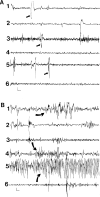The CRF1 receptor mediates the excitatory actions of corticotropin releasing factor (CRF) in the developing rat brain: in vivo evidence using a novel, selective, non-peptide CRF receptor antagonist
- PMID: 9372207
- PMCID: PMC3387933
- DOI: 10.1016/s0006-8993(97)00759-2
The CRF1 receptor mediates the excitatory actions of corticotropin releasing factor (CRF) in the developing rat brain: in vivo evidence using a novel, selective, non-peptide CRF receptor antagonist
Abstract
Corticotropin releasing factor (CRF) is the key coordinator of the neuroendocrine and behavioral responses to stress. In the central nervous system, CRF excites select neuronal populations, and infusion of CRF into the cerebral ventricles of infant rats produces severe age-dependent limbic seizures. These seizures, like other CRF effects, result from activation of specific receptors. Both of the characterized members of the CRF receptor family (CRF1 and CRF2), are found in the amygdala, site of origin of CRF-induced seizures, and may therefore mediate these seizures. To determine which receptor is responsible for the excitatory effects of CRF on limbic neurons, a selective, non-peptide CRF1 antagonist was tested for its ability to abolish the seizures, in comparison to non-selective inhibitory analogues of CRF. Pretreatment with the selective CRF1 blocker (NBI 27914) increased the latency and decreased the duration of CRF-induced seizures in a dose-dependent manner. The higher doses of NBI 27914 blocked the behavioral seizures and prevented epileptic discharges in concurrent electroencephalograms recorded from the amygdala. The selective CRF1 blocker was poorly effective when given systemically, consistent with limited blood-brain barrier penetration. Urocortin, a novel peptide activating both types of CRF receptors in vitro, but with preferential affinity for CRF2 receptors in vivo, produced seizures with a lower potency than CRF. These limbic seizures, indistinguishable from those induced by CRF, were abolished by pretreatment with NBI 27914, consistent with their dependence on CRF1 activation. In summary, CRF induces limbic seizures in the immature rat, which are abolished by selective blocking of the CRF1 receptor. CRF1-messenger RNA levels are maximal in sites of seizure origin and propagation during the age when CRF is most potent as a convulsant. Taken together, these facts strongly support the role of the developmentally regulated CRF1 receptor in mediating the convulsant effects of CRF in the developing brain.
Figures


Similar articles
-
Role of corticotropin releasing factor (CRF) receptors 1 and 2 in CRF-potentiated acoustic startle in mice.Psychopharmacology (Berl). 2003 Nov;170(2):178-87. doi: 10.1007/s00213-003-1535-6. Epub 2003 Jul 4. Psychopharmacology (Berl). 2003. PMID: 12845406
-
Recent advances with the CRF1 receptor: design of small molecule inhibitors, receptor subtypes and clinical indications.Curr Pharm Des. 1999 May;5(5):289-315. Curr Pharm Des. 1999. PMID: 10213797 Review.
-
Modulation of Ca2+ influx by corticotropin-releasing factor (CRF) family of peptides via CRF receptors in rat pancreatic beta-cells.Peptides. 2006 Jul;27(7):1814-9. doi: 10.1016/j.peptides.2006.01.011. Epub 2006 Feb 28. Peptides. 2006. PMID: 16513211
-
Stimulation of lateral septum CRF2 receptors promotes anorexia and stress-like behaviors: functional homology to CRF1 receptors in basolateral amygdala.J Neurosci. 2007 Sep 26;27(39):10568-77. doi: 10.1523/JNEUROSCI.3044-06.2007. J Neurosci. 2007. PMID: 17898228 Free PMC article.
-
Corticotropin-releasing factor receptors and urocortins, links between the brain and the heart.Eur J Pharmacol. 2010 Apr 25;632(1-3):1-6. doi: 10.1016/j.ejphar.2010.01.027. Epub 2010 Feb 2. Eur J Pharmacol. 2010. PMID: 20132811 Review.
Cited by
-
The developmental profile of the corticotropin releasing factor receptor (CRF2) in rat brain predicts distinct age-specific functions.Brain Res Dev Brain Res. 1998 Apr 17;107(1):81-90. doi: 10.1016/s0165-3806(98)00002-9. Brain Res Dev Brain Res. 1998. PMID: 9602071 Free PMC article.
-
Hippocampal neuroplasticity induced by early-life stress: functional and molecular aspects.Front Neuroendocrinol. 2006 Jul;27(2):180-92. doi: 10.1016/j.yfrne.2006.02.001. Epub 2006 Apr 17. Front Neuroendocrinol. 2006. PMID: 16603235 Free PMC article. Review.
-
Neuropeptides as targets for the development of anticonvulsant drugs.Mol Neurobiol. 2014 Oct;50(2):626-46. doi: 10.1007/s12035-014-8669-x. Epub 2014 Apr 6. Mol Neurobiol. 2014. PMID: 24705860 Free PMC article. Review.
-
Microinjections of urocortin1 into the nucleus ambiguus of the rat elicit bradycardia.Am J Physiol Heart Circ Physiol. 2011 Jan;300(1):H223-9. doi: 10.1152/ajpheart.00391.2010. Epub 2010 Oct 15. Am J Physiol Heart Circ Physiol. 2011. PMID: 20952663 Free PMC article.
-
Neuronal activity and stress differentially regulate hippocampal and hypothalamic corticotropin-releasing hormone expression in the immature rat.Neuroscience. 2000;101(3):571-80. doi: 10.1016/s0306-4522(00)00386-9. Neuroscience. 2000. PMID: 11113306 Free PMC article.
References
-
- Aldenhoff JB, Gruol DL, Rivier J, Vale W, Siggins GR. Corticotropin-releasing factor decreases postburst hyperpolarization and excites hippocampal neurons. Science. 1983;221:875–877. - PubMed
Publication types
MeSH terms
Substances
Grants and funding
LinkOut - more resources
Full Text Sources
Other Literature Sources

